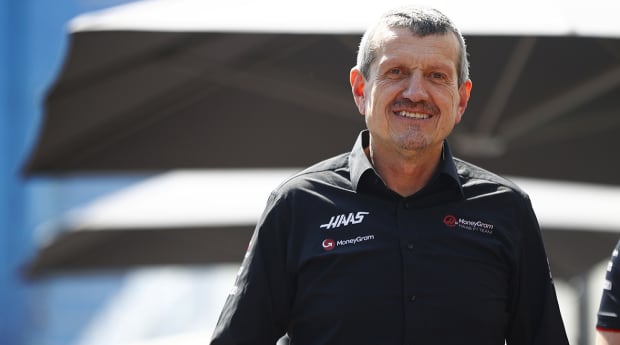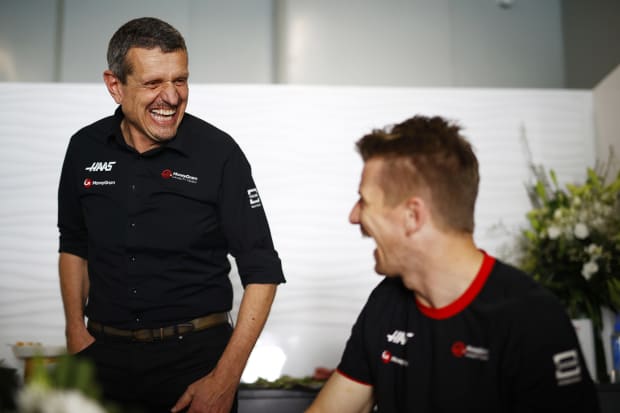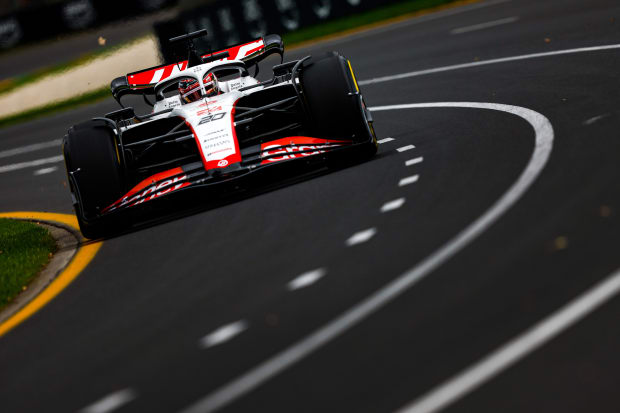From overseeing operations and technical development, to hiring and managing drivers, to making important decisions, the role of team principal on a Formula 1 team can be uniquely challenging. You’re responsible during the successes and also when things don’t go as planned.
When Guenther Steiner joined the Haas Formula 1 team, he had no idea he would become one of the most well-known faces in the paddock. Thanks to his no-nonsense and humorous management style—put on display on the hit Netflix show Drive To Survive—he is now one of the most-loved figures in the championship, sometimes more recognizable than the drivers.
In April, Steiner released a new book titled, Surviving to Drive, giving fans a glimpse into a whirlwind 2022 season at Haas, including the drama of an F1 racing calendar and the design, launch and testing of a car.
With Haas preparing for the Miami Grand Prix this weekend, one of three U.S. races for the team this year, Sports Illustrated caught up with the unlikely sensation.

Courtesy of Haas Formula 1 Team
Sports Illustrated: Formula One just had an uncharacteristic four-week break between Australia and Azerbaijan. How did you spend the time?
Guenther Steiner: I was on the book tour for a week, but otherwise, it’s just working like normal. You don’t take a break, but the good thing is I’ve had one more weekend off to stay home. It’s strange. I don’t know how many weeks it has been since Australia if you had asked me, because I lost sense of time. When you are in this routine, where you go at least every second week to race, it’s like, “Oh, we had three weekends off, or is it four, is it two?” It’s been good, though.
SI: What kind of hobbies do you have to take you out of that Formula One bubble? Is it a lot of family time, or have you got any other sports you enjoy watching or playing?
GS: No, I don’t play anything! When I get time off, I stay with the family because I don’t see them a lot otherwise. I watch NASCAR races in America to change it up a bit, or maybe some ice hockey.
SI: We’ve got three U.S. races now on the calendar. Which would you pick if you could replace Miami, Austin or Las Vegas with an existing race track in America?
GS: Long Beach, Calif., would be my favorite. The other ones don’t fit. Then the dream would be to do a street race in New York.
SI: The Miami Grand Prix is quickly approaching. How much more does your schedule and routine change during these American races?
GS: With Miami, it all starts on Wednesday lunchtime and finishes on Sunday night. It’s just one thing after the other, and, in between, we also have to go racing. Put it this way: The racing is the smallest part. There is so much going on with American partner sponsors like MoneyGram, Chipotle and Haas Automation, and now in the States, everybody wants to be part of F1. We need to do as much as we can for our partners, and we do.
SI: Do you find you’ve become as much of a poster boy for Haas as your drivers Nico Hulkenberg and Kevin Magnussen have?
GS: I don’t know about a poster boy! They use me more than before, maybe not as a poster boy, but to talk. The schedule is getting a lot heavier, and because so many people know me, when the drivers are fully booked, who is the fallback? It’s me—time for me to show up as the clown. I think it’s a good thing for the team, and it’s pretty easy to do. It is just time-consuming.

Courtesy of Haas Formula 1 Team
SI: When you agreed to star in the Netflix show Drive to Survive, did you ever imagine that you’d become so well known and such a star from it?
GS: I didn’t expect anything out of it, not good or bad. When they said they were doing this thing on Netflix, I said let’s do it. If you go back now, we all know what happened, who did what and how it was done, but some people didn’t want to take part at the time. People were awkward, but we just put on a smile and a microphone and went and did our job. Then the result from everybody was only seen a year later. When it aired, everybody said, “Wow, something big happened here”—with Formula One, not with me. I remember the discussion was whether we should even do the show. Some said no, it’s not worthwhile, and some teams wanted to do their own television show. … Can you imagine how boring that would be? Some teams did not participate in the first year because they thought it was nothing. But I didn’t envisage that anything like this would happen.
SI: In your book, Surviving to Drive, you mention that Netflix made you visit a vineyard with former Ferrari team principal Mattia Binotto for an episode. Have there been any other things they’ve persuaded you to do or pushed you in a particular direction?
GS: I kept it very authentic. Sometimes they ask to do things, and it’s immediately no. Going up the mountain I did two years ago with Netflix takes much longer because you always have to wait. After all, the filming crew needs to go ahead. It’s still enjoyable because I want to do it anyway, so it’s cool and not stuff I am forced to do. When they were at my house with Greta [Steiner’s daughter], we said let’s make a fun day out of it. Let’s do what we like instead of staging things because these are things people do anyway. We never staged a thing at the race weekend or did more than one try. If you don’t like it, wait until the next thing comes along. I’m not going to be an actor!
SI: I’m guessing having Netflix is also good for discovering new viewpoints during big moments within the team, like Magnussen’s pole in Brazil last year.
GS: Absolutely. These are my memories, and they don’t go away. If Netflix is around, it’s even better because people can live the enthusiasm with us and the joy.
SI: Why did you go for a year-in-review format and not an autobiography for your book?
GS: The idea didn’t come from me. I was against the idea of doing an autobiography, because there were not enough interesting things to write about and I didn’t want to do what everybody else does. I was not ready for that, and they came up with the idea of a year as Guenther as a team principal, and I liked it a lot better.
SI: If your book had been an autobiography, what would you have called it?
GS: I don’t know. I wouldn’t have anything ready for you and I honestly wouldn’t ever. Maybe A Strange Life.
SI: I like that. Which driver or team principal would you like to see write a book next?
GS: Oh, I am overthinking this. Toto Wolff [Mercedes-AMG PETRONAS F1 Team], because a lot of us don’t know where he really comes from. There’s still some mystery there. I know quite a bit about where he was before F1, so putting that on paper, I’ll pick him.

Courtesy of Haas Formula 1 Team
SI: How did you keep notes? Because part of this book is in a diary format. Were you sending voice notes to yourself?
GS: Debriefing after each race, immediately on Monday or Tuesday. No notes or anything. I’m not good at taking notes. Then speaking with the writer and just giving the download, I just told my story—a very simplistic way to do things.
SI: One of your drivers, Kevin Magnussen, said earlier that he still hasn’t got a copy of the book.
GS: He cannot afford it.
SI: Have people been bugging you in the paddock for a signed copy?
GS: Some people are asking, but I tell them to go and buy one because I need to make a living.
SI: Aside from your book, what was the last book you read?
GS: There is a story behind it. I read it on the way here on the plane. I still need to finish it, as I am a quarter through it. It’s Lee Child, and I have them all. I always buy the paperback, the small one, and the latest one just came out. Guess who produces it? Penguin! When I went into their office, there was a copy, and I took it, so I didn’t have to pay for it.







